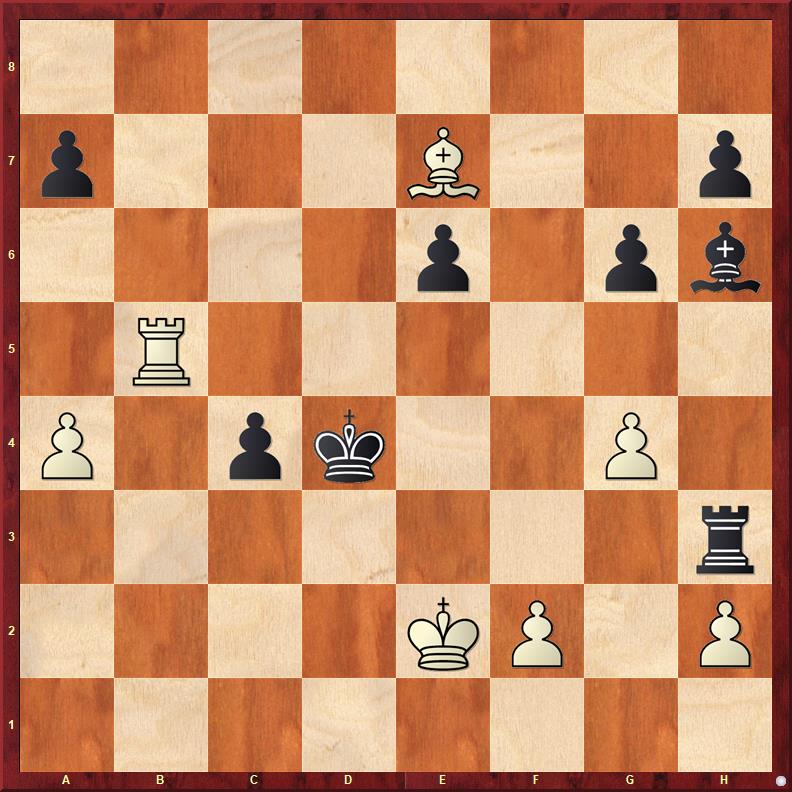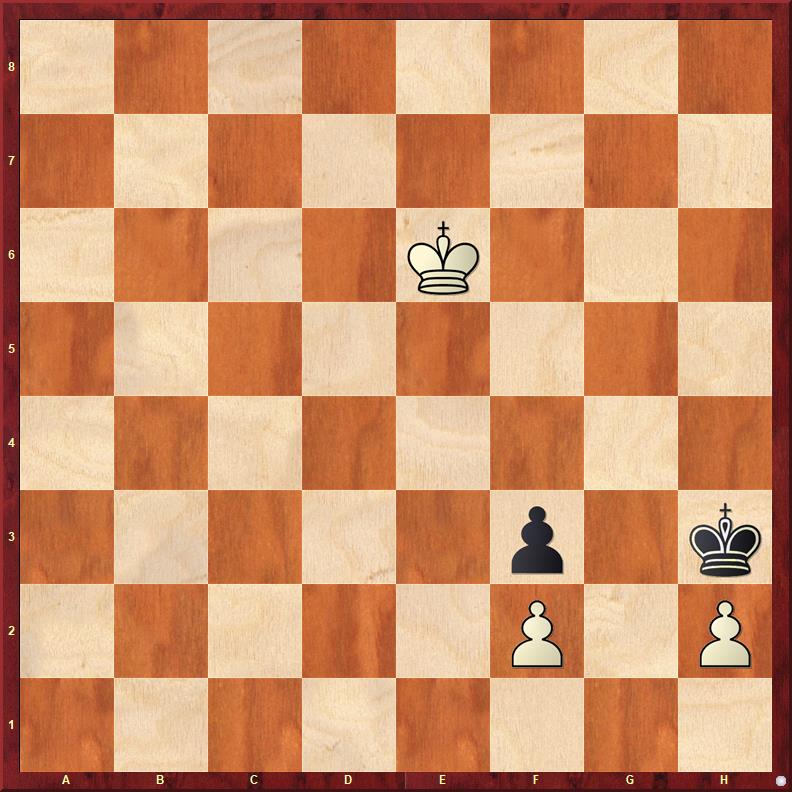I found this funny puzzle on the Chess Tactics app. It is white to move and win. How?
Read More »Category: endgame
A sneaky pawn endgame
Have you ever heard that pawn endgames are not as easy as they often seem? Probably. See for instance this study by Joseph Moravec (1925). What is your first thought when you see this position?
You probably think: it looks great for black. You are right: white has to fight for a draw. The question is can white make a draw?
Read More »Endgames can be highly tactical
 Off course there are general principles that apply to endgames. But mere intuition brings you most of the time nowhere. You have to calculate very careful.
Off course there are general principles that apply to endgames. But mere intuition brings you most of the time nowhere. You have to calculate very careful.
See this, seemingly simple rook endgame. If it was black to move, he would have a very easy draw. See for example this variation…
But it is white to move. That makes all the difference in the world. But how? That’s maybe not so easy to spot. Do you see how white can win? Solution…
Here is another one!
Some moments after I finished this post, I surfed to chess.com. Chess.com shows every day a new puzzle. Sometimes these puzzles are quite hard to solve. This one is also a bit tricky. See the second diagram.
 It is white to play and win. The first move is obvious. But then it gets a bit tricky. Do you see how to solve this one? Solution…
It is white to play and win. The first move is obvious. But then it gets a bit tricky. Do you see how to solve this one? Solution…
Goes without saying that not all rook endings end in a draw!
Endgame: rook versus pawn
 Winning an endgame with a rook against a lone pawn should be straightforward. But sometimes things are not so easy. These endgames can get a lot more complicated when the pawn is close to promotion.
Winning an endgame with a rook against a lone pawn should be straightforward. But sometimes things are not so easy. These endgames can get a lot more complicated when the pawn is close to promotion.
Even more problems might arise when the pieces of the stronger side are in the wrong places.
When both problems occur in the same position, the ‘stronger’ side might be dead lost. See the first diagram. This position was posted by international chess master Johan Salomon from Norway on his twitter account. It is white to play and win. Solution…Read More »
Tricky endgame
 In the foreword of his excellent book ‘Recognizing your opponent’s resources’ the author, Mark Dvoretsky’ writes:
In the foreword of his excellent book ‘Recognizing your opponent’s resources’ the author, Mark Dvoretsky’ writes:
‘Your opponent also has a right to exist – Savielly Tartakower remarked with his characteristic irony. Absorbed in our own thoughts, we sometimes forget this, for which we have to pay dearly.
As Viktor Korchnoi wrote, Well, if you do not check what your opponent is doing, you will end up complaining about bad luck after every game.’
Korchnoi’s statement is the reason why I stopped ‘wishing my opponent luck’. It implies that I wish myself to blunder. I hate making big mistakes! Nowadays I wish them a nice game and think ‘I hope my game will just be a bit more nice then yours!’
It’s great advice to take your opponent’s resources into account. It will net you a lot of extra points. We allways have to take care and ask ourselves:
‘Are there any threats’ and ‘What if I do…. how might my opponent react?’
Even the simplest positions sometimes hide unexpected tactical tricks. See the diagram*. At first glance it seems that white is completely winning. He simply queens his pawn (c7xb8Q) and will be a queen and a rook up. Also taking with the rook on b8 gives white more then enough material to win the game.
Or is this a bit too cheerful? Well see for yourself. White to play and win (yes, he has a win)! But it is no so easy as it looks. Solution…
*Source: Chessbites.com
Important endgame rule
 One of the most important endgame rules is ‘do not rush’! See the diagram.
One of the most important endgame rules is ‘do not rush’! See the diagram.
I found this position with Chess Club Live. It says ‘white to move’. I don’t know why, but I had a funny feeling and checked the position in Megabase.
This position was reached in a game from Anand against Comp Genius in de PCA/Intel GP London Rapid 1994. And my hunch was correct. There is something strange with this puzzle. It was not white to move in this position, but black! Does it make a difference?Read More »
King first
 In the middle game the king is usually a weak piece that we try to hide in a save place. But when most of the pieces came of the board, suddenly the monarch springs to life.
In the middle game the king is usually a weak piece that we try to hide in a save place. But when most of the pieces came of the board, suddenly the monarch springs to life.
The king can be a very dangerous attacker. The golden endgame rule is ‘king first’.
See the first diagram (I). This is of course a very simple endgame, we should all know how to win.
A terrible mistake would be to move the pawn first. In that case the black king simply stands in front of the pawn and white can’t make any progress. The correct way of course is to first move the king up the board and to get hold of the important squares in front of the pawn.
 Of course this is a very simple situation. The chances that we get this endgame on the board are very slim. But these simple examples are the building blocks for more complicated situations.Read More »
Of course this is a very simple situation. The chances that we get this endgame on the board are very slim. But these simple examples are the building blocks for more complicated situations.Read More »
Horrific mistake
The Norway Chess tournament is until now (after round 5) a very exciting tournament with lots of fighting chess and some spectacular upsets.
Who would have thought that Magnus Carlsen would be in the bottom half of the standings with a meager 1½ points after five rounds with still four rounds to go?
Magnus is joined in the lowest ranks by his fellow countryman Ludvig Hammer. That is not surprising because Ludvig is by far the lowest rated player (2677) of the line up. But he is of course still a very strong player.
See diagram. Hammer and Topalev reached this position after an exciting game. The position in the diagram should be a draw. White has two pawns for the piece.
Converting in the right moment to an endgame with the bishop and some pawns would yield a draw. And even when all the pawns disappear from the board white still has hope for a draw because the rook + bishop versus rook ending is, except for some positions, also a draw.
Although in that case black would definitely have practical chances. Unfortunetely even strong grandmasters sometimes make horrific mistakes in the endgame. As usual there is a big difference between ‘should be a draw’ and ‘is a draw’.
Endgame magic
 You don’t hear anything new when I tell you that Magnus Carlsen is a fantastic endgame player. He has a habit of winning his games from drawn or slightly better positions.
You don’t hear anything new when I tell you that Magnus Carlsen is a fantastic endgame player. He has a habit of winning his games from drawn or slightly better positions.
The diagram position is from his game with white against Shirov. Shirov is well known for his fantastic attacking style. But in this position it’s is clear he has to defend.
Maybe that was not his cup of tea? Shirov played 1. – Bg7? This is a mistake. He could have held the draw with 1. – Bb8 according to Krasenkow in Chessbase Magazine 125.
The question is: how did Magnus win? Solution…
With thanks to Dr. Karsten Müller – DVD Chess Endgames 14 – The Golden Guidlines of Endgame Play
#3 What is the threat? Dangling pieces
 Nowadays the talk is all about the youngsters in chess. The young generation rules the chess world. Therefore it is hard to imagine that somebody who is over sixty is able to compete with opponents who could have been his grand children.
Nowadays the talk is all about the youngsters in chess. The young generation rules the chess world. Therefore it is hard to imagine that somebody who is over sixty is able to compete with opponents who could have been his grand children.
It is what Emanuel Lasker did when he was well into his sixties. He was 67 when he played the newly crowned world champion Max Euwe in the Nottingham tournament of 1936. Lasker was more than thirty years older than Max Euwe.
In his encounters with Lasker Euwe had a bad track record. They played three games and Euwe lost them all. Okay, they played one more game against each other. In fact Lasker lost in a simul from the nineteen year old Max (1920). But that doesn’t count.
Lasker had a positive score against almost all the great players of his time. Just to mention a few:Read More »


